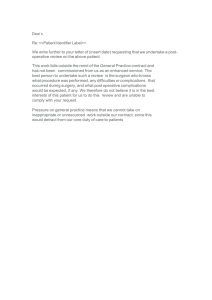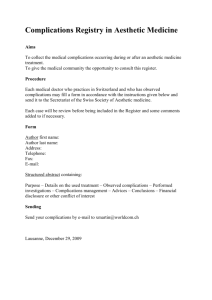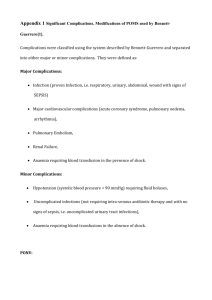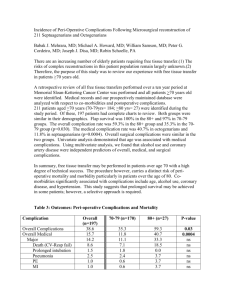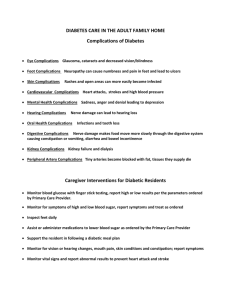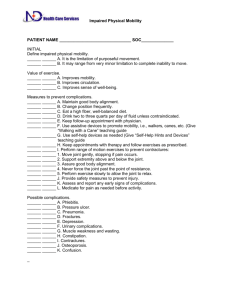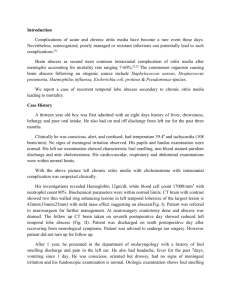COMPLICATIONS OF OTITIS MEDIA
advertisement
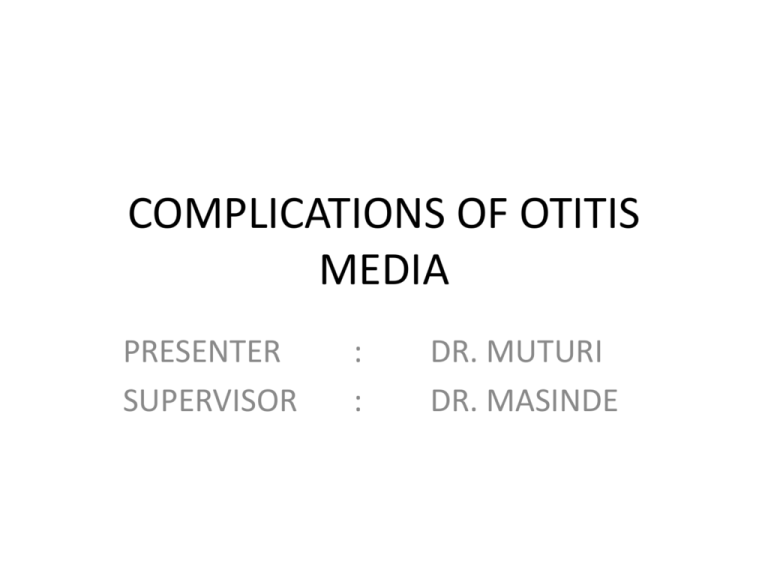
COMPLICATIONS OF OTITIS MEDIA PRESENTER SUPERVISOR : : DR. MUTURI DR. MASINDE OUTLINE • INTRODUCTION • EPIDEMIOLOGY • PATHOPHYSIOLOGY • CLASSIFICATION OF COMPLICATIONS • COMPLICATIONS • CONTROVERSY • FUTURE INTRODUCTION • Complications arising from acute/chronic otitis media cause great morbidity & mortality. • Antibiotics have reduced rate of complications. • Complications can occur at any age. • Mechanisms by which complications occur in acute otitis media (AOM) differ from those in chronic otitis media (COM). 1. Thorne MC, Chewaproug L, Elden LM. Suppurative complications of acute otitis media: changes in frequency in over. Arch otolaryngol Head Neck Surg 2009;135(7):638-641. EPIDEMIOLOGY • Mastoiditis incidence was 25-50% in preantibiotic era. • In the 1980s the incidence declined to 0.02% • Intracranial complications were reported at 0.36% by Kangsanarak at al.2 • In South Africa 80% extracranial & 70% intracranial complications occurred 1st -2nd decade in children.3 2. Kangsanarak J, Fooanant S, Ruckphaopunt K, et al. Extracranial and intracranial complications of suppurative otitis media. Report of 102 cases. J Laryngol Otol. Nov 1993;107(11):999-1004. 3. Singh B, Maharaj TJ: Radical mastoidectomy: its place in otitic intracranial complications. J Laryngol Otol 1993; 107:11131118. • In the 90s in Turkey 58% of both intra/extracranial cx were in patients <20years.4 • In Australia 3-5 children die each year while 15 get permanent hearing loss from complications of OM.5 • No reports on increased incidence in immunosuppressed patients so far. 4. Osma U, Cureoglu S, Hosgoglu S: The complications of chronic otitis media: report of 93 cases. J Laryngol Otol 2000; 114:97- 100. 5. O;Connor TE, Penny EF, Lannigan FJ. Complications of otitis media in indigenous and non-indigenous children. Med J Austr 2009;191(9):60. PATHOPHYSIOLOGY • Complications can arise within first few days on otitis media. • Spread of infection can occur through 3 main routes: Direct extension Thrombophlebitis Hematogenous dissemination. • There are various mechanisms that are responsible to the development of complications. • Complications influenced by a number of factors; – The virulence of the infecting organism and its sensitivity to antibiotics, – Host resistance, – The adequacy of antibiotic therapy, – The anatomic pathways and barriers to spread, and the drainage of the pneumatic spaces, both natural and surgical Bacteriology AOM COM Children Hemophilus influenza, Streptococcus pneumonia, Moraxella catarrhalis, Stapylococcus aureus Pseudomonus aeruginosa, Proteus, Escherichia coli, Staphylococcus aureus, Klebsiella, Bacteroides Adults Streptococcus pneumoniae, H. Pseudomonus aeruginosa, influenza, Moraxella catarrhalis, Proteus, Escherichia coli, Stapylococcus aureus Staphylococcus aureus, Klebsiella, Bacteroides CLASSIFICATION OF COMPLICATIONS • Complications are generally grouped into6: 1. Extracranial Intratemporal Extratemporal 2. Intracranial 6. Smith JA, Danner CJ. Complications of chronic suppurative otits media and cholesteatoma. Otolaryngol Clini North Am. 2006;39(6):1237-55 1. EXTRACRANIAL 1.Facial nerve Paralysis • Can occur due to dehiscence of the facial nerve canal • Erosion of the facial nerve canal. • Can be associated with acute, subacute or chronic otitis media. • Can occur with or w/out cholesteatoma. • Redaelli et al – use of antibiotic + corticosteriod therapy in patients with AOM.7 7. Redaelli de Z, LAO,Gampa P, Balzanelli C. Acute otitis medial and facial nerve paralysis in adults. Otology Neurology 2003;24(1):113=117 • In AOM IV antibiotics are recommended – 1st line is IV CoAmoxyclav. • If no response to treatment then mastoidectomy is done. • In COM a simple mastoidectomy is recommended. • Redaelli et al also reported normal function of facial nerve after treatment in AOM.7 2. Labyrinthitis • Occurs when the infection spreads to the inner ear. • Spread can occur though – Round/oval window 8 – SCC though bony erosion. • Otogenic suppurative labyrinthitis observed at any age group. • Serous labyrinthitis is more common in the pediatric age group. 8. Jang CH, Park SY, Wang PC. A case of tympanogenic labyrinthitis complicated by acute otitis media. Yonsei Med J. Feb 28 2005;46(1):161-5. • Morbidity due to bacterial labyrinthitis is significant. • Accounts for a third of all cases of acquired hearing loss. • Acute labyrinthitis: – Acute onset vertigo, hearing loss (profound), tinnitus, vertigo. – Nystagmus directed to affected ear • Chronic labyrinthitis: – Gradual onset vertigo, tinnitus, hearing loss • Evaluation:– History of ear disease – Vestibular assessment – Audiological tests • Treatment:– IV Antibiotics – Use of steroids – Mastoidectomy – Vestibular rehabilitation 3. Petrositis • Occurs when the infection spreads to the petrous apex. • Infection can spread from routes around the cochlear or around the SCC. • Incidence reported as 2/100,000 children with AOM.9 • Patient may present with a boaring headache & otorrhea. 9. Goldstein NA, Casselbrant ML, Bluestone CD, et al. Intratemporal complications of acute otitis media in infants and children. Otolaryngol Head Neck Surg 1998;119:444-54. • Important to remember – Gradenigo syndrome – Ipsilateral abduscence palsy, retrobulbar pain & persistent otorrhea • Diagnosis is confirmed via HRCT temporal bone. • Treatment IV antibiotics Surgical debribment - petrosectomy 4. Mastoiditis • This is inflammation of the mastoid air cell in the temporal one. • Acute mastoiditis more common and assoc with AOM. • Some patients may develop osteitis or periosteitis – either directly by bone erosion through the cortex or – indirectly via the emissary vein of the mastoid. • Chronic mastoiditis more assoc with COM. • Chronic mastoiditis also assoc with cholesteatoma. • Pathogenesis: Host factors –mucosal immunity, temporal bone anatomy, systemic immunity Microbial factors - protective coating, antimicrobial resistance, and ability to penetrate local tissue or vessels (ie, invasive strains). • Emergence on MDRSP as a cause of ASM may alter antimicrobial therapy.10 10. Ongkasuwan J, Valdez TA, Hulten KG, Mason EO Jr, Kaplan SL. Pneumococcal mastoiditis in children and the emergence of multidrugresistant serotype 19A isolates. Pediatrics. Jul 2008;122(1):34-9. • Incidence of surgical mastoiditis from acute otitis media is reported as 0.004% in the United States.11 • Persistent inflammation within mastoid air cells gives rise to coalescent mastoiditis. • Extensions of the mastoid infection may include: – Sigmoid sinus thrombosis, intracranial abscess, meningitis12 – Citelli’s abscess, Bezold’s abscess, Luc’s abscess. 11. Nussinovitch M, Yoeli R, Elishkevitz K, Varsano I. Acute mastoiditis in children: epidemiologic, clinical, microbiologic, and therapeutic aspects over past years. Clin Pediatr (Phila). Apr 2004;43(3):261-7. 12. Luntz M, Brodsky A, Nusem S, Kronenberg J, Keren G, Migirov L, et al. Acute mastoiditis--the antibiotic era: a multicenter study. Int J Pediatr Otorhinolaryngol. Jan 2001;57(1):1-9. • Imaging – HRCT of temporal bone • Presentation: – Otalgia, post-auricular pain, fever, hearing loss – Persistenet otorrhea, post, auricular swelling, – Headache, vertigo, tinnitus • Treatment – IV antibiotics – mastoidectomy INTRACRANIAL 1. CSF Otorrhea: • 0oocurs as a complication of chronic ear disease (COM). • Results from defect on the tegmen tympani. – Surgery, stapes surgery(“gusher”) • Presents as clear fluid draining through EAC, headache, • Seen on Ct scan of temporal bone as a defect on the tegmen tympani. • May also show either herniation of intracranial contents though defect • Cholesteatoma may be detected on CT scan as cause of the defect. • Repair of defect done though mastoidectomy • Materials used – fascia, muscle, cartilage, fat, bone. 2. Meningitis • This is a major and serous complication of otitis media. • It is the commonest reported complication. • Recovery from otogenic meningitis improved to 59% in postantibiotic era.13 • Major pathogens – H. influenza, S. pneumonea.14 • Polymicrobial infections are rare and account < 1%. 13. McLay K. Otogenic meningitis. J Laryngol Otol 1954;68:140–6. 14. Roos K, Scheld WM. Acute bacterial meningitis in children and adults. In: Scheld W, editor. Infections of the central nervous system. New York: Raven Press; 1991. p. 335–409. • Spread on infection through: – Retrograde thrombophlebitis – Bone erosion – Preformed pathways • Nager15 & Kaplan16 proposed mode of spread through perineural spaces to IAC & less frequently via endolymphatic ducts 15. Nager GT. Mastoid and paranasal sinus infections and their relation to the central nervous system. Clin Neurosurg 1966;14: 288–313. 16. Kaplan R. Neurological complications of infections of the head and neck. Otolaryngol Clin North Am 1976;9:729–49. • Proctor suggested spread through the labyrinth and petrous apex.17 • Presentation: – Otorrhea, otalgia, headache, fever – Vomiting, photophobia, vomiting, restlessness, irritability. – +ve Brudzinski’s and Kernig’s signs • Cawthorne noted that in AOM symptom progression was more rapid.18 17. Proctor CA. Intracranial complications of otitic origin. Laryngoscope 1966;76:288–308. 18. Cawthorne T. Otogenic meningitis. J Laryngol Otol 1939;54: 444–70. • CT scan on the brain will help to view surrounding structures. • MRI has better resolution of brain substance – Shows fluid in middle ear, inflammatory changes in the brain & meninges. • CSF should be obtained for m/c/s • Treatment – 3rd generation cephalosporins19 - Glucocorticoids (dexamethasone)20 19. Neely G. Intratemporal and intracranial complications of otitis media. In: Bailey B, editor. Otolaryngology-head and neck surgery. Philadelphia: Lippincott; 1993 20. Lebell M. Dexamethasone therapy for bacterial meningitis:results of 2 double blind placebo controlled trials. N Engl J Med 1988;319:964–6. • Surgery: – Cortical mastoidectomy for coalescent mastoiditis – Radical mastoidectomy for cholesteatoma 3. Brain Abscess • Local suppuration within the brain parenchyma surrounded by a region of encephalitis.21 • Demonstrates a bimodal distrubution:22 – Peaks – pediatric age group & 4th decade • In most series male:female ratio 3:123 • COM more likely cause than AOM & cholesteatoma accounts for most cases24.25 21. 22. 23. 24. 25. Scheld W. Bacterial meningitis and brain abscess. In: Isselbacher K, et al, editors. Harrison’s principles of internal medicine. 13th ed. New York: McGraw-Hill; 1994. p. 2296–309. de Souza CE GM. Complications of otitis media in children.In: de Souza CE SJ, Pellitteri PK, editors. Pediatric otorhinolaryngology head and neck surgery. San Diego, London: Singular; p. 115–35. Yen P, Chan S, Huang T. Brain abscess with special reference to otolaryngologic sources of infection. Otolaryngol Head Neck Surg 1995;113:5–22. Meyers E, Ballantine H. The management of otogenic brain abscess. Laryngoscope 1965;75:273–88. Sennaroglu L, Sozeri B. Otogenic brain abscess: review of 41 cases. Otolaryngol Head Neck Surg 2000;123:751–5. • 5% occur after mastoidectomy • Most abscesses located in cerebrum but the cerebellum also involved. • Mortality due to brain abscess 25%.26 • Multiple organisms reported (usually anaerobes) • Some gm –ve isolates include E.coli, Klebsiella, Pseudomonas. • H. influenza rarely found • Thrombophlebitis a preceding factor. 26. Kornblut AD. Cerebral abscess—a recurrent otologic problem. Laryngoscope 1972;82:1541–56. • Presentation: Drowsy, headache, confused, vomiting, foul smelling creamish discharge. Fever, lateralizing signs, papilloedema • CT scan – shows “ring sign” • MRI - shows more detail of brain parenchyma like surrounding cerebritis. • Treatment: High dose antimicrobial Neurosurgeon consultation to manage the abscess before Rx of primary infective site. Drainage of abscess controversial. 4. Thrombophlebitis • Simultaneous presence of venous thrombosis & suppuration in intracranial cavity. • Forms after infection spreads to the intima. • Sigmoid sinus mostly affected in AOM/COM • Beta-hemolytic Strep most common cause • Mechanism of formation of suppurative thrombophlebitis: • Presentation: – High fever with “picket fence” appearance – Restless, otalgia, blood stained otorrhea – Neck stiffness, papilloedema – Griensinger’s sign • CT scan – show “delta sight” at level of sigmoid sinus • MRI – shows blood flow, sinus obstruction & subsequent reversal flow. • Queckenstedts’ (or Tobey-Ayer) test used to detect lateral sinus thrombosis. • Treatment: Previously mastoidectomy with unroofing of sigmoid sinus was done Currently complete mastoidectomy with clearing of middle ear disease + antibiotics 5. Otitic Hydrocephalus • Term suggested by Symonds to describe syndrome assoc with: – Otitis media with increased intracranial pressure – Normal CSF findings, – Spontaneous recovery & no abscess • Rare but can occur in AOM/COM • Has favorable prognosis & assoc with sigmoid sinus thrombosis • Precise mechanism not known. Proposed: – Blocked arachnoid villi – Increased CSF volume – Brain edema – Changes in venous flow • MRI is imaging modality of choice • Treatment – Rx primary disease to reduce pressure – Corticosteroids, mannitol, diuretics, acetazolamide 6. Subdural Empyema • Collection of pus between dura & arachnoid membrane • Rate today due to increased use of antibiotics • Anatomically confined space, thus epyema can develop into fatal lesion • Presents as abrupt onset headache • MRI is investigation of choice • Treatment • A neurological emergency thus need drainage of • High dose antibiotic 7. Extradural Abscess • This presents as granulation tissue that is direct continuity with suppurative process in mastoid. • Usually precedes other intracranial complications. • Acute exacerbation of infection may cause silent extradural granulation into serious complication. • Usually asymptomatic unless very large • Treatment: If granulation tissue discovered during surgery than it should be carefully removed. CONTROVERSY • Whether to drain brain abscess or do medical treatment. FUTURE • Zinc supplementation for prevention of otitis media. 26. Gulani A, Sachdev HS. Zinc supplementation for preventing otitis media. Cochrane Library, 2012. REFERENCES 1. Thorne MC, Chewaproug L, Elden LM. Suppurative complications of acute otitis media: changes in frequency in over. Arch otolaryngol Head Neck Surg 2009;135(7):638-641. 2. Kangsanarak J, Fooanant S, Ruckphaopunt K, et al. Extracranial and intracranial complications of suppurative otitis media. Report of 102 cases. J Laryngol Otol. Nov 1993;107(11):999-1004. 3. Singh B, Maharaj TJ: Radical mastoidectomy: its place in otitic intracranial complications. J Laryngol Otol 1993; 107:11131118. 4. Osma U, Cureoglu S, Hosgoglu S: The complications of chronic otitis media: report of 93 cases. J Laryngol Otol 2000; 114:97100. 5. O;Connor TE, Penny EF, Lannigan FJ. Complications of otitis media in indigenous and non-indigenous children. Med J Austr 2009;191(9):60. 6. Smith JA, Danner CJ. Complications of chronic suppurative otits media and cholesteatoma. Otolaryngol Clini North Am. 2006;39(6):1237-55 7. Redaelli de Z, LAO,Gampa P, Balzanelli C. Acute otitis medial and facial nerve paralysis in adults. Otology Neurology 2003;24(1):113=117 8. Jang CH, Park SY, Wang PC. A case of tympanogenic labyrinthitis complicated by acute otitis media. Yonsei Med J. Feb 28 2005;46(1):161-5. 9. Goldstein NA, Casselbrant ML, Bluestone CD, et al. Intratemporal complications of acute otitis media in infants and children. Otolaryngol Head Neck Surg 1998;119:444-54. 10. Ongkasuwan J, Valdez TA, Hulten KG, Mason EO Jr, Kaplan SL. Pneumococcal mastoiditis in children and the emergence of multidrug-resistant serotype 19A isolates. Pediatrics. Jul 2008;122(1):34-9. 11. Nussinovitch M, Yoeli R, Elishkevitz K, Varsano I. Acute mastoiditis in children: epidemiologic, clinical, microbiologic, and therapeutic aspects over past years. Clin Pediatr (Phila). Apr 2004;43(3):261-7. 12. Luntz M, Brodsky A, Nusem S, Kronenberg J, Keren G, Migirov L, et al. Acute mastoiditis--the antibiotic era: a multicenter study. Int J Pediatr Otorhinolaryngol. Jan 2001;57(1):1-9. 13. McLay K. Otogenic meningitis. J Laryngol Otol 1954;68:140–6. 14. Roos K, Scheld WM. Acute bacterial meningitis in children and adults. In: Scheld W, editor. Infections of the central nervous system. New York: Raven Press; 1991. p. 335–409. 15. Nager GT. Mastoid and paranasal sinus infections and their relation to the central nervous system. Clin Neurosurg 1966;14: 288–313. 16. Kaplan R. Neurological complications of infections of the head and neck. Otolaryngol Clin North Am 1976;9:729–49. 17. Proctor CA. Intracranial complications of otitic origin. Laryngoscope 1966;76:288–308. 18. Cawthorne T. Otogenic meningitis. J Laryngol Otol 1939;54: 444–70. 19. Neely G. Intratemporal and intracranial complications of otitis media. In: Bailey B, editor. Otolaryngology-head and neck surgery. Philadelphia: Lippincott; 1993 20. Lebell M. Dexamethasone therapy for bacterial meningitis:results of 2 double blind placebo controlled trials. N Engl J Med 1988;319:964–6. 21. Scheld W. Bacterial meningitis and brain abscess. In: Isselbacher K, et al, editors. Harrison’s principles of internal medicine. 13th ed. New York: McGraw-Hill; 1994. p. 2296–309. 22. de Souza CE GM. Complications of otitis media in children.In: de Souza CE SJ, Pellitteri PK, editors. Pediatric otorhinolaryngology head and neck surgery. San Diego, London: Singular; p. 115–35. 23. Yen P, Chan S, Huang T. Brain abscess with special reference to otolaryngologic sources of infection. Otolaryngol Head Neck Surg 1995;113:5–22. 24. Meyers E, Ballantine H. The management of otogenic brain abscess. Laryngoscope 1965;75:273–88. 25. Sennaroglu L, Sozeri B. Otogenic brain abscess: review of 41 cases. Otolaryngol Head Neck Surg 2000;123:751–5. 26. Kornblut AD. Cerebral abscess—a recurrent otologic problem. Laryngoscope 1972;82:1541–56.
